
The TurboGrafx-16, known as the PC Engine outside North America, is a home video game console designed by Hudson Soft and sold by NEC Home Electronics. It was the first console marketed in the fourth generation, commonly known as the 16-bit era, though the console has an 8-bit central processing unit (CPU) coupled with a 16-bit graphics processor. It was released in Japan in 1987 and in North America in 1989. In Europe the Japanese model was unofficially imported and distributed in the United Kingdom and France from 1988. In Japan, the system was launched as a competitor to the Famicom, but the delayed United States release meant that it ended up competing with the Sega Genesis and later the Super NES.

Salamander, retitled Life Force in North America and in the Japanese arcade re-release, is a scrolling shooter arcade video game developed and published by Konami. Released in 1986 as a spin-off of Gradius, Salamander introduced a simplified power-up system, two-player cooperative gameplay and both horizontally and vertically scrolling stages. Some of these later became normal for future Gradius games. In Japanese, the title is written using ateji, which are kanji used for spelling foreign words that has been supplanted in everyday use by katakana. Contra, another game by Konami was also given this treatment, with its title written in Japanese as 魂斗羅.

Military Madness is a 1989 turn-based strategy video game originally developed and published by Hudson Soft in Japan and NEC in North America for the TurboGrafx-16. It is the first entry in the Nectaris series. Set in the year 2089, players take command of the Allied-Union forces in a desperate offense against the Axis-Xenon Empire army on the Moon before they launch the S.A.M. weapon to obliterate Earth. Its gameplay consists of moving units into positions to confront enemies in turn-based encounters determined by multiple factors, capturing factories to produce resources and repair units in order to occupy the enemy prison camp or destroy all enemy forces.
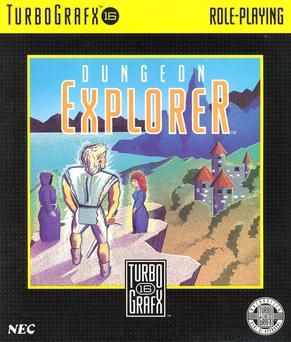
Dungeon Explorer is an action role-playing video game developed by Atlus for the TurboGrafx-16 and originally published by Hudson Soft in Japan on March 4, 1989, and later in North America by NEC on November 15 of the same year. The first installment in the eponymous franchise, the game is set in the land of Oddesia, which has been overrun by an alien race and where players assume the role of one of eight main characters tasked with recovering the Ora stone to kill the alien king Natas. Co-directed by Kazutoshi Ueda and Yōsuke Niino, the title was created by most of the same team that would work on later several projects such as entries in the Megami Tensei series. Though it was initially launched for the TurboGrafx-16, it was later re-released through download services for various consoles.

Dragon Spirit is a 1987 vertical-scrolling shooter arcade game developed and published by Namco. In North America, it was distributed by Atari Games. Controlling the dragon Amur, the player must complete each of the game's nine areas to rescue the princess Alicia from the demon Zawell. Similar to Namco's own Xevious, Amur has a projectile weapon for destroying air-based enemies and a bomb for destroying ground enemies. It ran on the Namco System 1 arcade board.
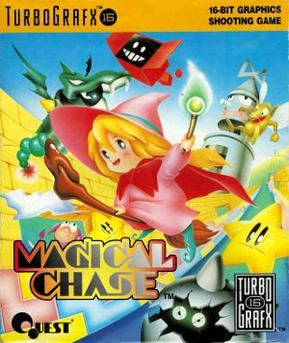
Magical Chase is a 1991 horizontally scrolling shooter video game developed by Quest and published by Palsoft and Turbo Technologies Inc. for the TurboGrafx-16. The game stars a young witch apprentice named Ripple, who broke a promise to her teacher by accidentally releasing six demons from a forbidden book, joined by her star companions Topsy and Turvy on a quest to catch and seal the demons back into the book.

Alien Crush is a pinball video game developed by Compile for the PC Engine/TurboGrafx-16. It was released in 1988. The game is the first installment in the Crush Pinball series. It was followed by three sequels, Devil's Crush, Jaki Crush, and Alien Crush Returns. Alien Crush was later re-released via emulation on the Virtual Console for Wii, 3DS, and Wii U, and for PlayStation 3 through PlayStation Network.

Neutopia II is a 1991 action-adventure/action role-playing video game developed and published in Japan by Hudson Soft and in North America by Turbo Technologies for the TurboGrafx-16. It is the sequel to Neutopia, which was released earlier in 1989. In the game, the player takes control of Jazeta's son, who embarks on a quest to both save his father and defeat the returning evil demon Dirth.

Gunhed, known as Blazing Lazers in North America, is a vertically scrolling shooter game by Hudson Soft and Compile, based on the Japanese film Gunhed. The title was released in 1989, for the PC Engine in Japan and re-skinned for the TurboGrafx-16 in North America, with Gunhed unofficially imported for the PC Engine in Europe. In the game, a fictional galaxy is under attack by an enemy space armada called the Dark Squadron, and this galaxy's only chance for survival is the Gunhed Advanced Star Fighter, who must destroy the Dark Squadron and its Super Weapons. The gameplay features fast vertical scrolling and a wide array of weapons for the player to use.
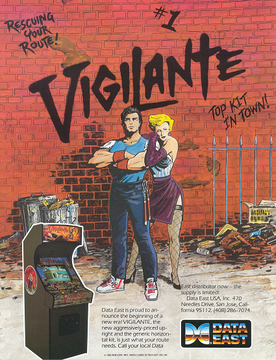
Vigilante (ビジランテ) is a 1988 beat 'em up arcade video game developed and published by Irem in Japan and Europe, and published in North America by Data East. It is considered as a spiritual sequel to Irem's earlier Kung-Fu Master (1984).

Chew Man Fu is a 1990 action video game developed by Now Production and published in Japan by Hudson Soft and in North America by NEC for the TurboGrafx-16.
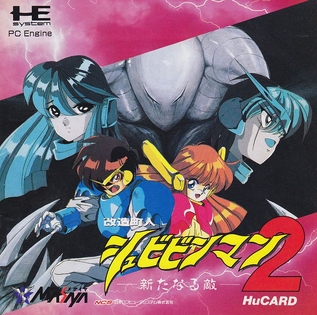
Shockman (known in Japan as Kaizō Chōjin Shubibinman 2: Aratanaru Teki is a 1991 video game developed by Winds and released exclusively for the TurboGrafx-16. It was released in the United States in 1992, making it the only game in the Kaizou Choujin Shubibinman series to be released outside Japan.

Drop Off is a Breakout clone by Data East. The game was published in 1990 for the PC Engine as Drop Rock Hora Hora and subsequently saw a US release for the TurboGrafx-16 as Drop Off.

Samurai-Ghost is a 1992 hack and slash video game released by Namco for the TurboGrafx-16. It is the sequel to Genpei Tōma Den. It was released on the Wii Virtual Console in North America on October 29, 2007, and in Europe on November 2, 2007.

Gate of Thunder is a 1992 scrolling shooter video game developed by Red Company and published by Hudson Soft for the TurboGrafx-CD. It was the first game released in North America to support the Super CD-ROM² format and served as one of the pack-in games for the TurboDuo, a two-in-one system which runs both TurboGrafx-CD and TurboGrafx-16 titles, where it was bundled with Bonk's Adventure, Bonk's Revenge and Bomberman on the same disc. In the game, the player controls the Hunting Dog space fighter craft, piloted by space cop Hawk. Alongside his ally Esty, piloting the Wild Cat support ship, Hawk must stop General Don Jingi and his Obellon armada from obtaining the powerful "Starlight" energy source from planet Aries.

Lords of Thunder is a horizontally scrolling shooter developed by Red Company and published in 1993 by Turbo Technologies and Hudson Soft for the TurboDuo. It is the unofficial follow-up to Gate of Thunder. The player controls the knight Landis, donning the armor of his ancestor Drak on a confrontation against Zaggart of Garuda Empire, who resurrected the evil god Deoric, and his six dark generals across the land of Mistral.
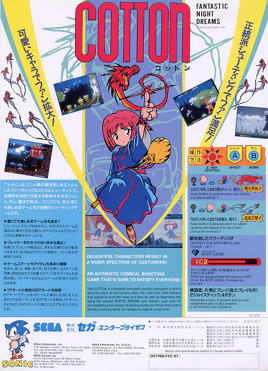
Cotton: Fantastic Night Dreams is a scrolling shooter video game developed by Success and originally released in Japanese arcades in 1991. The first installment in the Cotton series, players assume the role of the young witch Cotton who, alongside her fairy companion Silk, sets out on her broomstick on a quest to defeat several monsters and get her Willow candy. Its gameplay mainly consists of shooting mixed with role-playing game elements using a main two-button configuration. It ran on the Sega System 16 hardware.
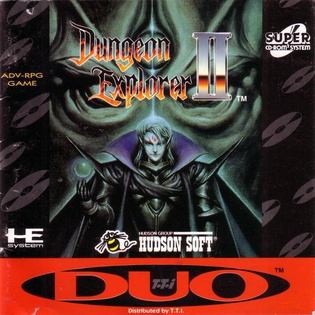
Dungeon Explorer II is an action role-playing video game developed and originally published by Hudson Soft for the TurboDuo in Japan on March 26, 1993, and in North America by Turbo Technologies in October of the same year. A sequel to 1989's Dungeon Explorer, it is the second installment in the eponymous franchise.

Seirei Senshi Spriggan is a 1991 vertically scrolling shooter video game developed by Compile and published by Naxat Soft in Japan for the PC Engine CD-ROM². In the game, the player assume control of Jega and Rikart piloting the Spriggan in order to protect their country from the Buraizubara empire.

Spriggan Mark 2: Re-Terraform Project is a 1992 horizontally scrolling shooter video game developed by Compile and published in Japan by Naxat Soft for the PC Engine Super CD-ROM². It is a follow-up to Seirei Senshi Spriggan (1991). The game follows lieutenant Greg Erwin piloting the armed Bartholomeu armor and later the Spriggan Mark 2 in a war between two opposing forces to decide the fate of a space colony at Mars. The player must fight against waves of enemies to avoid collision with their projectiles and other obstacles, while intermissions between characters during gameplay advances the storyline.




















